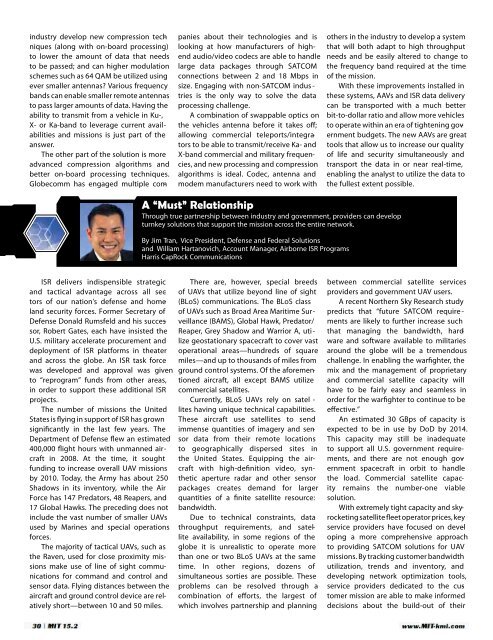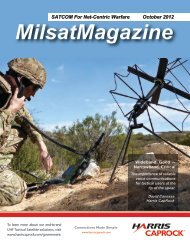Satcom for ISR - Harris CapRock
Satcom for ISR - Harris CapRock
Satcom for ISR - Harris CapRock
- No tags were found...
You also want an ePaper? Increase the reach of your titles
YUMPU automatically turns print PDFs into web optimized ePapers that Google loves.
industry develop new compression techniques<br />
(along with on-board processing)<br />
to lower the amount of data that needs<br />
to be passed; and can higher modulation<br />
schemes such as 64 QAM be utilized using<br />
ever smaller antennas? Various frequency<br />
bands can enable smaller remote antennas<br />
to pass larger amounts of data. Having the<br />
ability to transmit from a vehicle in Ku-,<br />
X- or Ka-band to leverage current availabilities<br />
and missions is just part of the<br />
answer.<br />
The other part of the solution is more<br />
advanced compression algorithms and<br />
better on-board processing techniques.<br />
Globecomm has engaged multiple companies<br />
about their technologies and is<br />
looking at how manufacturers of highend<br />
audio/video codecs are able to handle<br />
large data packages through SATCOM<br />
connections between 2 and 18 Mbps in<br />
size. Engaging with non-SATCOM indus -<br />
tries is the only way to solve the data<br />
processing challenge.<br />
A combination of swappable optics on<br />
the vehicles antenna be<strong>for</strong>e it takes off;<br />
allowing commercial teleports/integrators<br />
to be able to transmit/receive Ka- and<br />
X-band commercial and military frequencies,<br />
and new processing and compression<br />
algorithms is ideal. Codec, antenna and<br />
modem manufacturers need to work with<br />
others in the industry to develop a system<br />
that will both adapt to high throughput<br />
needs and be easily altered to change to<br />
the frequency band required at the time<br />
of the mission.<br />
With these improvements installed in<br />
these systems, AAVs and <strong>ISR</strong> data delivery<br />
can be transported with a much better<br />
bit-to-dollar ratio and allow more vehicles<br />
to operate within an era of tightening government<br />
budgets. The new AAVs are great<br />
tools that allow us to increase our quality<br />
of life and security simultaneously and<br />
transport the data in or near real-time,<br />
enabling the analyst to utilize the data to<br />
the fullest extent possible.<br />
A “Must” Relationship<br />
Through true partnership between industry and government, providers can develop<br />
turnkey solutions that support the mission across the entire network.<br />
By Jim Tran, Vice President, Defense and Federal Solutions<br />
and William Hartanovich, Account Manager, Airborne <strong>ISR</strong> Programs<br />
<strong>Harris</strong> <strong>CapRock</strong> Communications<br />
<strong>ISR</strong> delivers indispensible strategic<br />
and tactical advantage across all sectors<br />
of our nation’s defense and homeland<br />
security <strong>for</strong>ces. Former Secretary of<br />
Defense Donald Rumsfeld and his successor,<br />
Robert Gates, each have insisted the<br />
U.S. military accelerate procurement and<br />
deployment of <strong>ISR</strong> plat<strong>for</strong>ms in theater<br />
and across the globe. An <strong>ISR</strong> task <strong>for</strong>ce<br />
was developed and approval was given<br />
to “reprogram” funds from other areas,<br />
in order to support these additional <strong>ISR</strong><br />
projects.<br />
The number of missions the United<br />
States is flying in support of <strong>ISR</strong> has grown<br />
significantly in the last few years. The<br />
Department of Defense flew an estimated<br />
400,000 flight hours with unmanned aircraft<br />
in 2008. At the time, it sought<br />
funding to increase overall UAV missions<br />
by 2010. Today, the Army has about 250<br />
Shadows in its inventory, while the Air<br />
Force has 147 Predators, 48 Reapers, and<br />
17 Global Hawks. The preceding does not<br />
include the vast number of smaller UAVs<br />
used by Marines and special operations<br />
<strong>for</strong>ces.<br />
The majority of tactical UAVs, such as<br />
the Raven, used <strong>for</strong> close proximity missions<br />
make use of line of sight communications<br />
<strong>for</strong> command and control and<br />
sensor data. Flying distances between the<br />
aircraft and ground control device are relatively<br />
short—between 10 and 50 miles.<br />
There are, however, special breeds<br />
of UAVs that utilize beyond line of sight<br />
(BLoS) communications. The BLoS class<br />
of UAVs such as Broad Area Maritime Surveillance<br />
(BAMS), Global Hawk, Predator/<br />
Reaper, Grey Shadow and Warrior A, uti -<br />
lize geostationary spacecraft to cover vast<br />
operational areas—hundreds of square<br />
miles—and up to thousands of miles from<br />
ground control systems. Of the a<strong>for</strong>ementioned<br />
aircraft, all except BAMS utilize<br />
commercial satellites.<br />
Currently, BLoS UAVs rely on satel -<br />
lites having unique technical capabilities.<br />
These aircraft use satellites to send<br />
immense quantities of imagery and sensor<br />
data from their remote locations<br />
to geographically dispersed sites in<br />
the United States. Equipping the aircraft<br />
with high-definition video, synthetic<br />
aperture radar and other sensor<br />
packages creates demand <strong>for</strong> larger<br />
quantities of a finite satellite resource:<br />
bandwidth.<br />
Due to technical constraints, data<br />
throughput requirements, and satellite<br />
availability, in some regions of the<br />
globe it is unrealistic to operate more<br />
than one or two BLoS UAVs at the same<br />
time. In other regions, dozens of<br />
simultaneous sorties are possible. These<br />
problems can be resolved through a<br />
combination of ef<strong>for</strong>ts, the largest of<br />
which involves partnership and planning<br />
between commercial satellite services<br />
providers and government UAV users.<br />
A recent Northern Sky Research study<br />
predicts that “future SATCOM require -<br />
ments are likely to further increase such<br />
that managing the bandwidth, hardware<br />
and software available to militaries<br />
around the globe will be a tremendous<br />
challenge. In enabling the warfighter, the<br />
mix and the management of proprietary<br />
and commercial satellite capacity will<br />
have to be fairly easy and seamless in<br />
order <strong>for</strong> the warfighter to continue to be<br />
effective.”<br />
An estimated 30 GBps of capacity is<br />
expected to be in use by DoD by 2014.<br />
This capacity may still be inadequate<br />
to support all U.S. government requirements,<br />
and there are not enough government<br />
spacecraft in orbit to handle<br />
the load. Commercial satellite capacity<br />
remains the number-one viable<br />
solution.<br />
With extremely tight capacity and skyrocketing<br />
satellite fleet operator prices, key<br />
service providers have focused on devel -<br />
oping a more comprehensive approach<br />
to providing SATCOM solutions <strong>for</strong> UAV<br />
missions. By tracking customer bandwidth<br />
utilization, trends and inventory, and<br />
developing network optimization tools,<br />
service providers dedicated to the customer<br />
mission are able to make in<strong>for</strong>med<br />
decisions about the build-out of their<br />
30 | MIT 15.2<br />
www.MIT-kmi.com




